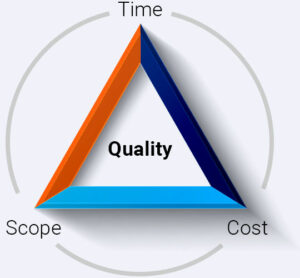
PROJECT MANAGEMENT
In a perfect world scenario, project managers have unlimited time, all the resources they need, and the scope of the project never changes. However, in the real world, nothing could be further from the truth. Every project, small or big, has constraints, and it's the project managers job to deliver quality projects within these limitations.
-
Most common constraints PMs have when starting the new project include time, cost, and scope. Together they make what we call project management triangle.
-
This article will help you understand the project management triangle better, overview its challenges, and let you know how can you use it for delivering quality projects.
You might come across the same model with a different name, such as the iron triangle, project triangle, or triple constraint. These names indicate just how important this model is and how helpful can it be for the project managers. It is not a new concept either; Managers have been using the triple constraints model for a long time. However, despite its age, it remains to be one of the most vital parts of project management till today.

The three angles of the project management are interdependent. One cannot change the scope of the project, delivery time, or the cost of it, without it affecting the other two.
To understand the project management triangle better and see how are they connected, let's break down each of the angles.
Before the project starts, the project manager together with the development team estimates the time of completion for each task. By adding these tasks together and considering the interdependent and related work, the project manager sets the timeline of the project. After the client agrees on the deadline, the development team is ought to deliver the project on time. (if of course, the client does not make any changes in the scope or price).
-
However, every project manager knows that often, not everything goes as planned. Here are some of the most common time-related challenges that the project manager might face. Knowing them will help you mitigate such risks before they even arise. -
Sometimes the team is too optimistic when estimating the time needed for completion of tasks. As a result, amid project development, it gets clear that there is a low chance of meeting deadline. It results in constant delays and puts stress on the team, as well as the client.
-
Hence, it is wise to consider each team members' abilities and workload to create a schedule that reflects reality. At the same time, take a look at the similar projects your company has completed before and use past experiences. -
The correct estimation is not the solution to all time-related issues. If your project has the logic of dependencies and team members have to sit around doing nothing, while the other team completes their tasks, you are spending money and time. While working on such projects, you need to create such a timeline than considers dependencies. Have constant communication between team members, so everyone is aware of the current situation to reduce internal delays.
When the team is understaffed and not enough skilled people are working on the project, delays are inevitable. Project managers can resolve minor staffing issues more easily by prioritizing and moving tasks around. In more critical situations, they can even outsource fraction of the project, or temporarily recruit developers for the job. However, if the team lacks professionals with the key skill sets, the project can be significantly delayed. It is why it is so important to plan the project and form the team based on the scope and client's requirements.
-
Project delays will negatively affect the relationship with the client and as a result, can damage the company's reputation. Changes in time can affect the other two parts of the project management triangle and have an impact on the project quality. To avoid it, project managers should use time management and prioritization technique:
Going over the project's budget might be a nightmare for project managers. But sometimes it is impossible to avoid. How carefully PMs might decompose and plan the project the cost might still change.
-
While often they cannot control changes in cost, the best way to deal with it is to plan and try to prevent any possible exceeds in the budget.
-
Cost underestimation
Cost underestimation happens when the initial estimates are too optimistic, don't include possible inefficiencies and when there are mistakes in the budget.
-
Project delays
When the team does not meet the project deadline, you can always expect changes in the budget. The budget should account for the additional salaries and other possible costs that arise. If the delay is significant, there might even be fines to pay for it, if indicated in the initial contract.
As mentioned above, project managers can mitigate some of the staffing issues by moving the tasks around. However, if the team has to outsource or hire an outside contractor, they also have to spend more money. Such situations arise, when there is a lack of skilled members in the team or when the tasks are not assigned properly. As a result, some of the tasks have to be redone by more experienced members. Again, it results in exceeding the agreed budget.
-
The best way to deal with the changes in the cost is to prevent it from happening by thorough planning and estimating. Project managers can minimize overruns by adding the contingency budget into the plan. They should check if the budget follows the initial estimates and make necessary changes if something does not go according to it.
-
Changes in scope can sometimes set the whole project upside down as it greatly affects the time and budget.
Request for an additional issue can come both externally and internally.
If the additional feature does not require a lot of work, does not change the dependencies and you cannot accommodate it within the set timeline and budget, it is not a big problem. By implementing it, you can make the final product more valuable. If not, you need to be firm and make how adding it will affect the time and cost.
-
Changing specifications
Sometimes the client does not have a clear understanding of what kind of software they want to develop, simply because they do not have technical knowledge. Throughout the project development, they might re-evaluate their needs and come up with the suggestion to change some of the specifications so, that the software accommodates their needs better. Needless to say, will affect the budget and schedule of the project.
-
Best way to avoid it is to document all requirements and specifications and communicate it openly with the client and the team. All parties that are involved in the project should sign the documentation that defines the deliverables, specifications and other details regarding the project.
-
If the client still requests changes, you can enact a change control process for those changes that affect the budget and time. -
Even when the project requirements are detailed and written, a lot of issues might arise. Imagine what can happen if they are ambiguous and open from interpretation. To avoid such complications, project managers need to have detailed requirement analysis and do a precise project decomposition.
Project management triangle is a give-and-take balance that is the core of delivering a quality project that is beneficial and valuable for the client and the development company.
-
The iron triangle helps project managers understand the limits of the project and guides them into the daily decision-making process. It is also a good reminder that the project cannot meet all the expectations, be cheap and be developed quickly. The key is to balance all three components and while doing so, deliver the maximum quality.
With an eye on outcomes that are efficient in time and cost, more and more businesses in today's global economy choose to outsource
Data management refers to the process of collecting, storing, organizing, and maintaining data. It is now
The choice of whether to keep services in-house or outsource them has become a crucial factor as businesses work to optimize...
Receive the latest industry news, trends and interesting blogposts for your business improvements directly in your inbox.
Join our newsletter
Receive the latest industry news, trends and interesting blogposts for your business improvements directly in your inbox.
Thank you for subscribing to our newsletter!
By clicking "Subscribe" you agree to our Privacy Policy and Cookie Policy